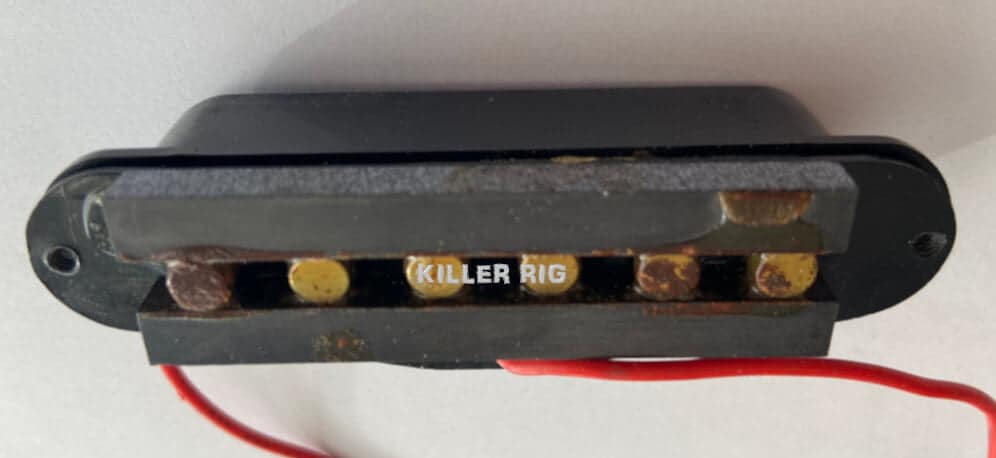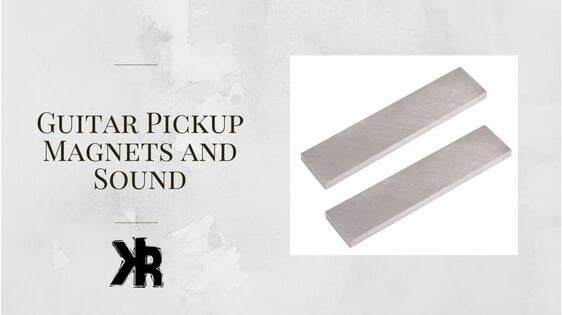Table of Contents
Guitar pickup magnets play an important role, but most people know very little about them. Most guitarists only think about the number of wraps of wire and pole pieces.
To them, these are the sole contributors to their sound. But the pickup is a complex piece of equipment that requires a magnet to do the heavy lifting.
The size and type of magnet that is used play an important role in the tone of the guitar pickups output.
The magnetic field converts string vibration into an electrical signal. The magnet’s shape, strength, and size all play a role in how pickups sound.
In this Killer Rig article, we are going to look at different types of guitar pickup magnets. And how you should choose the right one for your tone.
Magnet Type Summary
If you want to learn about the pickup magnets, keep reading. If you’re in a hurry and just need a quick comparison, here is what you can expect from the magnet types:
- Alnico 2: smooth, warm tone. They have the lowest output of all the types.
- Alnico 3: Darker sound with a glassy top-end. They produce slightly more output than the Alnico 2. Great for neck pickups.
- Alnico 4: You can expect a pretty balanced tone from these magnets. The output is good for hard rock and softer genres.
- Alnico 5: balanced by punchy sound. This is due to their more aggressive nature. These are the more common magnets found in pickups.
- Alnico 8: The highest output possible with Alnico magnets is found in these pickups. Their sound is somewhat balanced and are good for harder genres of music.
- Ceramic: like the Alnico 8 magnet types, ceramics have a similar output. Their sound is unique and can benefit a guitar made for extreme metal.
Guitar Pickup Magnets
There are a few different types of magnets used in guitar pickups. They are generally made from Alnico, ceramic, or a combination of other materials.
Alnico is an alloy made of aluminum, nickel, and cobalt. They get their name from the first two letters of the materials they are made from, Al-ni-co.
It was one of the first materials used in pickups because it’s very strong and produces a clear tone. The main downside to Alnico is that it can lose its magnetism over time.
Iron oxide and strontium carbonate are used to make ceramic magnets. They don’t lose their magnetism as quickly as Alnico, and they are less expensive to create.
Ceramics have the drawback of having a brittle, harsh tone. They are also known as ferrite magnets.
Some guitar pickups use a combination of Alnico and ceramic magnets. This gives the pickup a balance of clarity and power.
Alnico magnets come in a different range of strength and composition. The material recipe used to make them is altered. This results in a series of Alnico magnets as follows.
- Alnico II.
- Al-ni-co III.
- Alnico V.
- Al-ni-co VIII.
Each of these Alnico types has a specific sonic signature. This means certain magnets work better for some music styles. But also the position they are placed on the electric guitar.

Ever wonder if guitar pickups wear out? Click here!
Alnico II
Alnico II magnets are not very strong and have a small pull on the strings as a result. This provides a more dynamic picking response and a warmer, loose tone. These are often found in original PAF humbuckers.
They are a soft, bright, and clear-sounding magnet type. They don’t produce any harshness in the tone. Some players describe them as sweet sounding and have a singing type of articulation.
Alnico II magnets are great when used for country, blues, classic rock, and folk music.
Alnico III
Alnico III magnets are the weakest of all available variants. They produce a spongy, compressed sound with a bold low-end response. You will find them in the neck position more often because of the perfect output.
They have some similar tonal qualities to Alnico II magnets. But the lower magnetic force allows strings to ring out longer and very clearly.
Alnico III magnets are best used for Rock, Funk, and Blues music styles.
Further learning: How do pickups work?
Alnico V
These are the most common. They are normally found in guitars made for more aggressive music styles.
They produce a bright, aggressive output with lots of mid-range. This results in a thick sound that is still very articulate, great for rhythm or lead tones.
Players find that chords are full. They have a good bite with high-gain settings and ring out long enough to be just right.
You can find Alnico V magnets being used for rock, metal, funk, and even jazz music styles.

Alnico VIII
Alnico VIII magnets are one of the stronger types. They were designed to create a more powerful output. All while keeping the feel and tone that is associated with lower-strength magnets.
The sound produced is thick, full, and very aggressive. You will find them mostly in high-output humbuckers meant for heavier music.
They have a pick attack all their own, but can also be very bright sounding depending on the build. But when it comes to aggression and precision, these can’t be beaten when it comes to Alnico magnets.
Because they have such a higher output, you will normally find these magnets used in pickups made for hard rock and metal music.
Want to learn more about the different types of pickups? Click here!
Ceramic
Ceramic magnets are considered to be the most aggressive of any available. They are bright sounding with lots of output and a very present low-end response. They also have a bold mid-range that adds some amazing thickness and clarity.
Ceramic magnets are perfect for high-gain. They are very tight in the low-end and are quite modern sounding.
They have a very fast pick attack that is perfect for players who want to dig in and get aggressive with their sound.
Just like Alnico VIII pickups, ceramics are made for hard rock and metal forms of music.
| Alnico | Ceramic |
|---|---|
| Expensive | Cheaper |
| Used Less In Pickups | Used More In Pickups |
| Identification is difficult | Easy To Identify |
| Natural, warm tone | Bright, aggressive tone |
| Conductive | Non-conductive |
| Better for a wide range of music styles | Limited to certain music styles |
Learn how to identify which pickups are in your guitar. Click here!
Conclusion
Guitar pickups are made with different materials. This depends on the style of music they are meant for. Alnico and ceramic magnets are two of the most common materials used to create these pickups.
Each type has a specific sound that is ideal for various musical genres. It’s crucial to take your intended musical style into account when selecting a guitar pickup. This will assist you in selecting the best magnet material for your needs.
FAQs
Why do guitar pickups have magnets?
Magnets in a guitar pickup are responsible for the electromagnetic field. This field is what “pickups up” the vibrations from the strings. Then converts them into an electrical signal. Without this field, your guitar would be silent.
What is the best magnet for a guitar pickup?
This question lacks a definite response. Your personal preferences and the genre of music you’ll be playing will determine this.
Some guitarists prefer the sound of Alnico pickups. While others prefer the sound of ceramic. Ultimately, it is up to you to decide which sound is best for your needs.
How do I know which magnet is in my guitar pickup?
To find which magnet is in your electric guitar pickup, look at the manufacturer’s specs. Most manufacturers will list the type of magnet used in their pickups.
If you cannot find this information, you can always contact the manufacturer directly.

